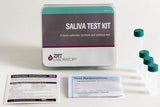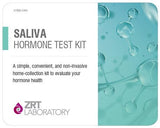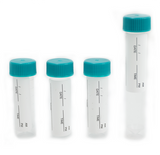Hormone Acne Saliva Profile
At-home saliva test for acne-related hormone imbalance. Measures Estradiol (E2), Testosterone (T), Progesterone (Pg), and DHEAS (DS) to pinpoint drivers of breakouts and guide targeted care.
What it tests
- Estradiol (E2): Cycle regulation. Low/high shifts can trigger breakouts.
- Testosterone (T): Androgen excess increases oil and clogged pores.
- Progesterone (Pg): Luteal-phase changes link to premenstrual acne.
- DHEAS (DS): Adrenal androgen that elevates sebum via conversion to T.
- Click to see >> Saliva Sample Test Result Report
Why this matters for acne
Androgens raise sebum, keratin build-up, and inflammation. Mapping E2, Pg, T, and DHEAS clarifies if flare-ups are cycle-related, stress-driven, or androgen-dominant so treatment targets the root cause.
Key features
- Comprehensive 4-hormone panel tied to acne pathways
- Non-invasive saliva collection at home
- Bioavailable levels reported in graphs + numbers
- Expert comments from a PhD hormone specialist with next steps
- Fast results: 3–5 working days after lab receipt
- All-inclusive price: lab fee included
- Valid 12 months from purchase
- You ship the sample using your preferred carrier
- For adults and children
Who should use it
- Persistent or cystic acne
- Premenstrual flares
- Late-onset or stress-related breakouts
- Suspected androgen excess or adrenal involvement
- Monitoring response to anti-androgens, OCPs, or lifestyle changes
How it works
- Order the kit.
- Collect saliva at home per instructions.
- Post to the lab.
- Review your report and tailored guidance in 3–5 working days.
What’s included
- Collection kit and instructions
- Laboratory analysis of E2, T, Pg, DHEAS
- Visual dashboard + reference ranges
- PhD specialist interpretation and actionable recommendations
FAQ
What hormones are measured?
Estradiol, Testosterone, Progesterone, and DHEAS.
Is saliva testing accurate for acne hormones?
Yes. It reflects bioavailable (active) fractions that drive skin oil and inflammation.
When should females collect?
Ideal: luteal phase (about cycle day 19–21). If cycles are irregular, follow kit guidance.
When should males collect?
Any morning, ideally 7–10 a.m.
Do I need to stop medications or HRT?
Follow your clinician’s advice. Note all hormones/meds on the form for proper context.
How fast are results?
3–5 working days after the lab receives your sample.
What will the report include?
Hormone charts, numeric values, reference ranges, and PhD commentary with next steps.
Can this diagnose PCOS or other conditions?
It does not diagnose. It flags patterns that warrant clinical follow-up.
Will results change treatment?
They can guide targeted options: anti-androgens, cycle support, stress and sleep protocols, diet changes, or dermatology therapies.
Are lab fees included?
Yes. Shipping to the lab is your responsibility.
How to use:










